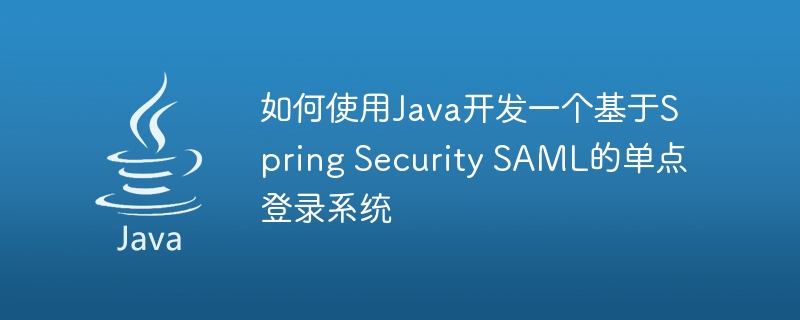Java を使用して Spring Security SAML ベースのシングル サインオン システムを開発する方法

Java を使用して Spring Security SAML に基づくシングル サインオン システムを開発する方法
はじめに:
インターネットの急速な発展に伴い、さらに多くのアプリケーションプログラムが開発されています。これらのアプリケーションでは、ユーザー ログインは最も一般的な機能の 1 つです。ただし、エンタープライズ レベルのアプリケーションの場合、ユーザーは複数のシステムにログインする必要があるため、ユーザーのログイン エクスペリエンスが非常に低下します。この問題を解決するために登場したのがシングルサインオンシステム(Single Sign-On、以下SSO)です。
はじめに:
シングル サインオン システムを使用すると、ユーザーは一度ログインすると、ログイン資格情報を繰り返し入力することなく、企業内のさまざまなシステムにあるアプリケーションにアクセスできます。 Spring Security は強力なセキュリティ フレームワークであり、SAML (Security Assertion Markup Language) はクロスドメイン認証および認可のオープン標準です。
この記事では、Java を使用して Spring Security SAML に基づくシングル サインオン システムを開発する方法を紹介し、具体的なコード例を示します。
ステップ 1: 準備
- Java、Spring Boot、Maven をインストールします。
- Spring Boot プロジェクトを作成し、依存関係を追加します: spring-boot-starter-security、spring-security-saml2-core、spring-security-saml2-service-provider。
ステップ 2: SAML の構成
- SP メタデータ、IDP メタデータ、およびキー情報を application.properties ファイルに構成します。
# SP元数据 security.saml2.metadata.sp.entity-id= security.saml2.metadata.sp.private-key-location= security.saml2.metadata.sp.public-key-location= # IDP元数据 security.saml2.metadata.idp.entity-id= security.saml2.metadata.idp.single-sign-on-service.location= security.saml2.metadata.idp.single-logout-service.location= # 密钥信息 security.saml2.keystore.location= security.saml2.keystore.password= security.saml2.private-key.password=
- 「SAMLWebSecurityConfig」という名前の Java クラスを作成し、「SAMLConfigurerAdapter」を継承して、対応するメソッドをオーバーライドします。
@Configuration
@EnableWebSecurity
public class SAMLWebSecurityConfig extends SAMLConfigurerAdapter {
@Autowired
private SAMLUserDetailsService samlUserDetailsService;
@Override
protected void configure(HttpSecurity http) throws Exception {
http.authorizeRequests()
.antMatchers("/saml/**").permitAll()
.anyRequest().authenticated()
.and()
.apply(saml())
.userDetailsService(samlUserDetailsService);
}
@Override
protected void configure(AuthenticationManagerBuilder auth) throws Exception {
auth.authenticationProvider(samlAuthenticationProvider());
}
@Bean
public SAMLConfigurer saml() {
return new SAMLConfigurer();
}
@Bean
public SAMLAuthenticationProvider samlAuthenticationProvider() {
return new SAMLAuthenticationProvider();
}
}- 「SAMLConfigurer」という名前の Java クラスを作成し、「SAMLConfigurerAdapter」を継承して、対応するメソッドをオーバーライドします。
public class SAMLConfigurer extends SAMLConfigurerAdapter {
@Override
public void configure(SAMLServiceProviderConfigurer saml) throws Exception {
saml.keyStore()
.storeFilePath(keystoreLocation)
.password(keystorePassword)
.keyname(keyAlias)
.keyPassword(keyPassword)
.and()
.protocol(PROTOCOL)
.hostname(HOSTNAME)
.basePath(BASE_PATH)
.entityId(SP_ENTITY_ID)
.metadataFilePath(SP_METADATA_LOCATION);
}
}ステップ 3: ユーザー サービスの作成
- 「SAMLUser」という名前の Java クラスを作成し、「SAMLUserDetailsService」インターフェイスを実装し、対応するメソッドを実装します。
@Service
public class SAMLUser implements SAMLUserDetailsService {
@Override
public Object loadUserBySAML(SAMLCredential credential) throws UsernameNotFoundException {
String username = credential.getNameID().getValue();
// 根据用户名查询用户信息
// ...
// 返回用户详细信息
return new User(username, "", new ArrayList<>());
}
}ステップ 4: コントローラーの作成
- ログイン成功後のジャンプを処理する「HomeController」という名前の Java クラスを作成します。
@Controller
public class HomeController {
@RequestMapping("/")
public String home() {
return "home";
}
}- ログアウトを処理する「LogoutController」という名前の Java クラスを作成します。
@Controller
public class LogoutController {
@RequestMapping("/logout")
public String logout() {
return "logout";
}
}ステップ 5: ビューの作成
- 2 つのテンプレート ファイル home.html と logout.html を src/main/resources/templates ディレクトリに作成します。
home.html:
<!DOCTYPE html>
<html>
<head>
<meta charset="UTF-8">
<title>Home</title>
</head>
<body>
<h1>Welcome to Home Page</h1>
</body>
</html>logout.html:
<!DOCTYPE html>
<html>
<head>
<meta charset="UTF-8">
<title>Logout</title>
</head>
<body>
<h1>You have been logged out</h1>
</body>
</html>概要:
これまでのところ、Java を使用した Spring Security SAML の開発は完了しました。シングルサインオンシステムの手順。 SAML を構成し、ユーザー サービスを作成することで、優れたユーザー エクスペリエンスを提供する安定した安全なログイン システムを実装できます。
参考:
- Spring Security SAML 公式ドキュメント: https://docs.spring.io/spring-security-saml/docs/current/reference/htmlsingle/
以上がJava を使用して Spring Security SAML ベースのシングル サインオン システムを開発する方法の詳細内容です。詳細については、PHP 中国語 Web サイトの他の関連記事を参照してください。

ホットAIツール

Undresser.AI Undress
リアルなヌード写真を作成する AI 搭載アプリ

AI Clothes Remover
写真から衣服を削除するオンライン AI ツール。

Undress AI Tool
脱衣画像を無料で

Clothoff.io
AI衣類リムーバー

AI Hentai Generator
AIヘンタイを無料で生成します。

人気の記事

ホットツール

メモ帳++7.3.1
使いやすく無料のコードエディター

SublimeText3 中国語版
中国語版、とても使いやすい

ゼンドスタジオ 13.0.1
強力な PHP 統合開発環境

ドリームウィーバー CS6
ビジュアル Web 開発ツール

SublimeText3 Mac版
神レベルのコード編集ソフト(SublimeText3)

ホットトピック
 7569
7569
 15
15
 1386
1386
 52
52
 87
87
 11
11
 28
28
 108
108
 ジャワのウェカ
Aug 30, 2024 pm 04:28 PM
ジャワのウェカ
Aug 30, 2024 pm 04:28 PM
Java の Weka へのガイド。ここでは、weka java の概要、使い方、プラットフォームの種類、利点について例を交えて説明します。
 Java Springのインタビューの質問
Aug 30, 2024 pm 04:29 PM
Java Springのインタビューの質問
Aug 30, 2024 pm 04:29 PM
この記事では、Java Spring の面接で最もよく聞かれる質問とその詳細な回答をまとめました。面接を突破できるように。
 Java 8 Stream Foreachから休憩または戻ってきますか?
Feb 07, 2025 pm 12:09 PM
Java 8 Stream Foreachから休憩または戻ってきますか?
Feb 07, 2025 pm 12:09 PM
Java 8は、Stream APIを導入し、データ収集を処理する強力で表現力のある方法を提供します。ただし、ストリームを使用する際の一般的な質問は次のとおりです。 従来のループにより、早期の中断やリターンが可能になりますが、StreamのForeachメソッドはこの方法を直接サポートしていません。この記事では、理由を説明し、ストリーム処理システムに早期終了を実装するための代替方法を調査します。 さらに読み取り:JavaストリームAPIの改善 ストリームを理解してください Foreachメソッドは、ストリーム内の各要素で1つの操作を実行する端末操作です。その設計意図はです
 Java での日付までのタイムスタンプ
Aug 30, 2024 pm 04:28 PM
Java での日付までのタイムスタンプ
Aug 30, 2024 pm 04:28 PM
Java での日付までのタイムスタンプに関するガイド。ここでは、Java でタイムスタンプを日付に変換する方法とその概要について、例とともに説明します。
 カプセルの量を見つけるためのJavaプログラム
Feb 07, 2025 am 11:37 AM
カプセルの量を見つけるためのJavaプログラム
Feb 07, 2025 am 11:37 AM
カプセルは3次元の幾何学的図形で、両端にシリンダーと半球で構成されています。カプセルの体積は、シリンダーの体積と両端に半球の体積を追加することで計算できます。このチュートリアルでは、さまざまな方法を使用して、Javaの特定のカプセルの体積を計算する方法について説明します。 カプセルボリュームフォーミュラ カプセルボリュームの式は次のとおりです。 カプセル体積=円筒形の体積2つの半球体積 で、 R:半球の半径。 H:シリンダーの高さ(半球を除く)。 例1 入力 RADIUS = 5ユニット 高さ= 10単位 出力 ボリューム= 1570.8立方ユニット 説明する 式を使用してボリュームを計算します。 ボリューム=π×R2×H(4
 未来を創る: まったくの初心者のための Java プログラミング
Oct 13, 2024 pm 01:32 PM
未来を創る: まったくの初心者のための Java プログラミング
Oct 13, 2024 pm 01:32 PM
Java は、初心者と経験豊富な開発者の両方が学習できる人気のあるプログラミング言語です。このチュートリアルは基本的な概念から始まり、高度なトピックに進みます。 Java Development Kit をインストールしたら、簡単な「Hello, World!」プログラムを作成してプログラミングを練習できます。コードを理解したら、コマンド プロンプトを使用してプログラムをコンパイルして実行すると、コンソールに「Hello, World!」と出力されます。 Java の学習はプログラミングの旅の始まりであり、習熟が深まるにつれて、より複雑なアプリケーションを作成できるようになります。






